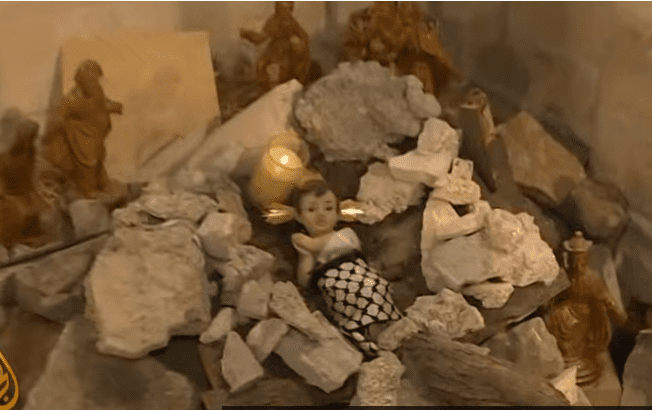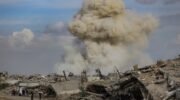Health, safety, and humanitarian updates for Gaza; Israel vows attacks in south will be worse than north, considers flooding tunnels; West Bank, Jerusalem, and Israel news; US government continues to support Israel, and more
Health and safety:
UNICEF spokesperson says alleged Gaza safe zones are ‘zones of death’ In a Sky News interview, UNICEF spokesperson James Elder says Israel’s proclaimed ‘safe zones’ in Gaza are ‘zones of death’ with increased risk for disease. Elder says Israeli authorities are fully aware of the dire consequences in the alleged safe zones, and that the decision to push 80% of the population into a zone that is 4% the size of Gaza is ‘cold’ and ‘calculated’ and lacks ‘any sense of decency’.
Khan Younis and Rafah: Monday night was terrifying for residents of Khan Younis and Rafah, and 1.5 million evacuees. Since early yesterday evening, there has been non-stop heavy artillery shelling, relentless air strikes and mass bombardment.
The vast majority of residential homes and public facilities – schools, hospitals, medical centers and shops – in the eastern side of Khan Younis, have been completely destroyed. At the same time, people were ordered to evacuate in the middle of the night and early hours of this morning under heavy bombardment.
As ambulances tried to get to the eastern side of Khan Younis to Abasan al-Kabira and Bani Suheila, where people were stranded and caught under the heavy bombardment, they were shot at and could not evacuate any of the injured or bring out any of those who were killed overnight.
The Nasser Medical Complex in Khan Younis has called for blood donations due to the high number of severely injured patients arriving every hour. Twenty-six out of 35 hospitals in Gaza are currently out of service, and 52 out of 72 primary healthcare clinics have been shut down.
Palestinian officials in Gaza say Israeli jets dropped phosphorus bombs north and east of Khan Younis. (Use of white phosphorus in civilian areas is considered a war crime due to its extremely dangerous effects on the human body. White phosphorus ignites instantly when in contact with oxygen. It can burn through the human body, including through bone, causing severe, excruciating damage. It can also cause extreme harm when inhaled, with risks of suffocation, cardiovascular failure, coma, death, and other lifelong effects. The substance burns at temperatures of up to 1,500 degrees Fahrenheit.)

The Palestinian Red Crescent Society (PRCS) has shared footage of the moment an Israeli artillery tank targeted the vicinity of two ambulances in Gaza. PRCS said the two ambulances were attending to casualties in Deir el-Balah, southern Gaza.
Northern Gaza: Gaza’s health ministry is warning of a “massacre” at Kamal Adwan Hospital in northern Gaza, where Israeli tanks and snipers are reportedly surrounding the facility and “shooting at anyone who moves”; Israeli forces have already killed 108 civilians and injured dozens in the hospital’s vicinity. Munir al-Bursh, director-general of the Health Ministry in Gaza, said,
The Israeli occupation forces have laid siege to the facility from all sides. Patients and those who took shelter here are gripped with fear and overwhelmed by horror.
The Israeli forces are attacking with the aim of forcibly removing all those inside the hospital. These are patients, victims and displaced civilians.
We, the medical staff, are holding our ground. We are standing by our patients. We will continue to serve our people by all means left here at Kamal Adwan Hospital.
UN says no place is safe: The United Nations warns that creating “so-called safe zones” for civilians to flee to within the Gaza Strip is impossible amid Israel’s bombing campaign. The Israeli army, which initially focused much of its offensive on the north of the enclave, has now dropped leaflets on parts of the south, telling Palestinian civilians there to flee to other areas. “The so-called safe zones … are not scientific, they are not rational, they are not possible, and I think the authorities are aware of this,” said UNICEF spokesperson James Elder.
Journalists face grave threats: The Committee to Protect Journalists (CPJ) reports that 63 journalists and media workers have been killed since October 7. The overall death toll includes 56 Palestinians, four Israelis and three Lebanese nationals. Sherif Mansour, CPJ’s Middle East and North Africa program coordinator, said,
CPJ emphasizes that journalists are civilians doing important work during times of crisis and must not be targeted by warring parties. Journalists across the region are making great sacrifices to cover this heart-breaking conflict. Those in Gaza, in particular, have paid, and continue to pay, an unprecedented toll and face exponential threats.
Humanitarian update
UNRWA Commissioner-General Philippe Lazzarini said the resumption of the Israeli military operation and its expansion further in southern Gaza is repeating horrors from past weeks. He added,
The latest developments are further strangling the humanitarian operation, with limited supplies going in and complex logistical and coordination arrangements that slow down and at times obstruct the flow. The Israeli Authorities continue to restrict the flow of humanitarian supplies, including fuel, forcing the UN to only use the ill-equipped crossing point with Egypt.
We call on the State of Israel to reopen Kerem Shalom and other crossings and facilitate the unconditional, uninterrupted and meaningful delivery of lifesaving humanitarian assistance. The failure to do so violates international humanitarian law.
On 4 December, 100 aid trucks carrying humanitarian supplies and 69,000 litres of fuel entered from Egypt into Gaza, about the same as the previous day. This is well below the daily average of 170 trucks and 110,000 litres of fuel that had entered during the humanitarian pause implemented between 24 and 30 November.
On 4 December, for the second consecutive day, Rafah was the only governorate in Gaza where limited aid distributions, primarily of flour and water, took place.
On 4 December at about 20:30, the main telecommunication provider in Gaza announced that all telecom services had shut down due to cuts in the main fibre routes. This followed a partial shutdown in Gaza city and northern Gaza a few hours earlier due to ongoing hostilities. Humanitarian agencies and first responders have warned that blackouts jeopardize the already constrained provision of life-saving assistance.

Other Gaza updates
Agriculture destroyed: Human Rights Watch (HRW) has found that orchards, greenhouses and farmland have been razed due to Israel’s ground invasion in the north of Gaza. In Beit Hanoun in northeast Gaza, what was once green agricultural land has now become “brown and desolate”, increasing concerns about food insecurity and the loss of livelihoods.
The razing continued during the seven-day truce and satellite imagery showed the destruction of farmland by Israel’s use of bulldozers to carve new roads for its armored vehicles.
Israel set to possibly flood Gaza’s tunnel system: the Wall Street Journal reports:
Israel has assembled a system of large pumps it could use to flood Hamas’s vast network of tunnels under the Gaza Strip with seawater, a tactic that could destroy the tunnels and drive the fighters from their underground refuge but also threaten Gaza’s water supply, U.S. officials said.
The Israel Defense Forces finished assembling large seawater pumps roughly one mile north of the Al-Shati refugee camp around the middle of last month. Each of at least five pumps can draw water from the Mediterranean Sea and move thousands of cubic meters of water per hour into the tunnels, flooding them within weeks.
Sentiment inside the U.S. was mixed. Some U.S. officials privately expressed concern about the plan, while other officials said the U.S. supports the disabling of the tunnels and said there wasn’t necessarily any U.S. opposition to the plan. The Israelis have identified about 800 tunnels so far, though they acknowledge the network is bigger than that.
Because it isn’t clear how permeable the tunnels are or how much seawater would seep into the soil and to what effect, it is hard to fully assess the impact of pumping seawater into the tunnels, said Jon Alterman, senior vice president at the Washington-based Center for Strategic and International Studies.
“It’s hard to tell what pumping seawater will do to the existing water and sewage infrastructure. It is hard to tell what it will do to groundwater reserves. And it’s hard to tell the impact on the stability of nearby buildings,” Alterman said.
RECOMMENDED READING: ICRC president describes human suffering in Gaza as ‘intolerable’
Attacks on southern Gaza promise to be “worse” than north: Yoav Gallant, the Israeli defense minister, has been saying that what will come to the southern part of the Gaza Strip will not only be equal to what we saw in the north but, actually, even worse. He says the army is going to continue its ground operation inside of the northern part of the Gaza Strip. He also said that Israeli troops are going to remain stationed there until every single Hamas target – infrastructure and fighters – is eliminated.

RECOMMENDED READING: Is Israel’s Gaza bombing also a war on the climate?
West Bank, Jerusalem, and Israel news
Israeli settlers break into Jerusalem’s Aqsa mosque: Dozens of fanatic Israeli settlers Tuesday morning broke into the compounds of al-Aqsa Mosque under heavy protection from the Israeli police. The extremist settlers divided into groups, raided the holy Islamic Mosque from al-Maghariba gate and took provocative tours in its compounds. The settlers performed Talmudic rituals in the eastern part of the Mosque.
Jerusalem Palestinian killed: A Palestinian was Tuesday morning killed, while his brother was detained, by Israeli forces during a raid in Qalandia camp, north of occupied Jerusalem. Witnesses said that the occupation forces violently stormed Manasra’s and blew up the door of the house just as he was about to open it, with a bomb that disintegrated his body. The occupation forces later detained his brother before they withdrew.
Israel says Jerusalemite children released in recent prisoner swap can’t go back to school: Families of the child prisoners released in the recent exchange deal said that the schools’ administrations affiliated with the so-called Israeli Ministry of Education and the occupation municipality in Jerusalem refused the return of their children to school.
2 Palestinians killed Monday night: Two Palestinian youths was Monday evening killed after they were shot by Israeli occupation forces in the town of Sa’ir, northeast of Hebron. The Ministry of Health said that Anas Ismail al-Froukh, 23, and Mohammad Saa’di al-Frouk, 22, died due to their severe injuries by Israeli forces.
Major new settlement plan approved for occupied East Jerusalem: Ir Amim, an organization that focuses on the Israel-Palestine conflict in Jerusalem, says that amid the ongoing war in Gaza, Israel is seeking to expand the settler presence in occupied East Jerusalem. “Today, officials shockingly announced the approval of the Lower Aqueduct plan – the first major new settlement plan to be fully approved in East Jerusalem since [the settlement of] Givat Hamatos in 2012,” the group said.
This plan has disastrous ramifications, the group said, predicting “It will extend the Israeli settlement wedge along East Jerusalem’s southern boundary, further sealing [it] off from the southern West Bank, while fracturing the Palestinian space and depleting more vacant land for Palestinian development.”
Israel says three more soldiers were killed during fighting on Tuesday and four others were seriously injured in various battles in northern Gaza. More than 80 Israeli soldiers have been killed in Gaza since the start of the ground invasion of the Palestinian enclave, the UN said on Tuesday, citing official Israeli sources. It was not known if the latest deaths announced by Israel were part of that total.
RECOMMENDED VIEWING: Watch: Debunking Israel’s “mass rape” propaganda
The firing of rockets by Palestinian armed groups towards Israeli population centers has continued over the past 24 hours, with no reported fatalities. (Information on rocket attacks is here.) It appears that the last time a rocket killed an Israeli was October 7-8, as reported by Ha’aretz and the Times of Israel. 15 Israelis were killed – 10 of them Palestinian Israelis who reportedly had no access to bomb shelters. Rockets have killed a total of 35 Israelis over the 22 years they’ve been fired,.
Elsewhere
Resigned US State Department official reveals details of child rape case in Israeli prison, calls for accountability: In a CNN interview, former US State Department official Josh Paul discloses a troubling incident involving the alleged rape of a 13-year-old Palestinian boy in an Israeli prison. The State Department’s inquiry into the case resulted in Israeli officials shutting down the charity involved in bringing the case to light.
Paul condemned ongoing atrocities in Gaza and the West Bank and called for accountability. He questioned the US foreign policy’s impact on global perceptions and whether the US is using its ‘leverage’ to end the Israeli onslaught on Gaza.
Josh Paul resigned from the US State Department in October over the Biden administration’s decision to continue sending weapons and ammunition to Israel following the Israeli war on Gaza.
Some Democratic senators say that Israel’s military must adopt substantive measures to lessen civilian deaths in Gaza as part of receiving the supplemental $14.3 billion in US aid for Israel’s war, but only a few call for a ceasefire (Bernie Sanders is not among them). House Resolution 786 calling for a ceasefire has 17 cosponsors. (Bernie Sanders is not among them.)
Poll shows split support in US for Israel’s war on Gaza: A survey by US polling agency Gallup shows among members of US President Joe Biden’s Democratic Party, only 36 percent support the war as opposed to 71 percent among opposition Republican Party members.
Biden received a 32 percent approval rating for his handling of the Gaza conflict. Also, four in 10 Americans surveyed say the US is sending too little aid to the Palestinians in Gaza.
This Republican-led resolution threatens both Jewish and Palestinian safety, ignores the threat of rising white nationalism, and is a direct attack on free speech.
Every member of Congress should vote against it. 🧵 https://t.co/916Nj9NKwR
— Jewish Voice for Peace Action (@JvpAction) December 4, 2023
🚨PRCS: We have completely lost contact with the operations room in the #Gaza Strip and all our teams operating there due to the fourth telecommunication blackout during the ongoing aggression on the #Gaza Strip.#NotATarget#IHL pic.twitter.com/5L41PQY06B
— PRCS (@PalestineRCS) December 4, 2023
View this post on Instagram
Statistics as of Dec. 4:
Palestinian death toll: OCHA reports at least 15,688* (~15,428 in Gaza** (4,257 women and 6,387 children), and at least 260 in the West Bank). This does not include an estimated 7,000 more still buried under rubble. Euro-Med Monitor reports 20,360 Palestinian deaths.
*IAK does not yet include 471 Gazans killed in the Al Ahli hospital blast since the source of the projectile is being disputed; although much evidence points to Israel as the culprit, experts are still looking into the incident. Israel is blocking an international investigation. Israel killed more Palestinians in a little over a month after Oct. 7 than in all the previous 22 years combined.
Palestinian injuries: 44,595** (including at least 42,000 in Gaza** and 3,365 in the West Bank). **NOTE: it is impossible to offer an accurate number of injuries in Gaza due to the ongoing bombardment and communication disruption.
It remains unknown how many Americans are among the casualties. in Gaza**. About 1.8 million people have been displaced (nearly 80% of the population).
Reported Israeli death toll ~1,200 (7 killed in West Bank, 80 in Gaza), including 32 Americans, and 5,431 injured, approximately 30 children).
NOTE: It is unknown at this time how many of the deaths and injuries in Israel may have been caused by Israeli soldiers; additionally, since Israel has a policy of universal conscription, it is unknown how many of those attending the outdoor rave a few miles from Gaza on stolen Palestinian land were Israeli soldiers.
Find previous daily casualty figures and daily news updates here. For more news, go here and here.**** Live broadcast news from the region is here.
RELATED READING:
- US poised to give Israel $18 billion in aid this year
- Gaza Civilians, Under Israeli Barrage, Are Being Killed at Historic Pace
- Israel has lost control of the narrative – October 7 truths coming out
- Essential facts and stats about the Hamas-Gaza-Israel war
- What media reports fail to tell you about October 7
- More Palestinians killed in past 34 days than in the past 22 years combined





